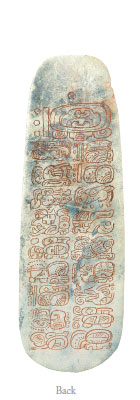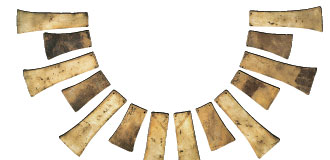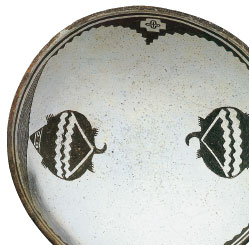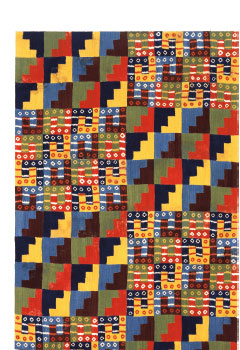





Gold in ancient Peru was associated with masculine energy and the
sun. The reflective nature of gold made it valued. Necklaces such as
this suggested the connection between the kings and chiefs, who wore
them, with the sun.


The ancient Maya developed characters to write the names of their
founders on monuments and used several calendars to record their
history. This celt or ritual ax represents the rachis of a corn leaf
and was worn around the waist in sets of three. Incised on the front
is a chief performing an important ritual at a major juncture of the
long calendar, which was the time of the gods. The inscription on
the back explains this.
The people of the ancient Americas sought sacred power and spirits
everywhere and did not consider humans superior to animals.
According to the creation myth of the Native Americans, after the
great flood, the Turtle created the earth and symbolizes the
blessings of nature and the origin of life. The Turtle was also
associated with longevity and ancestor worship. During burials, a
bowl such as this was used to cover the deceased’s head, which was
bore with holes.





The ancient south Andean peoples developed the world’s most
elaborate textiles. Woven fabrics were traded, stored, and offered to
the gods and ancestors in large bundles. The large piece here is
made of colorful tie-dye blocks of J-shaped and triangular-step
patterns, composed of reciprocal exchanges of warps and wefts, sewn
together. The ancient Andean people considered cloth to be sacred
and valued its above all else in much the same way that the
Mesoamericans prized jade.
The Mesoamerican ballgame was a hallmark of all its ancient
societies. The balls were made of rubber, and the players wore
helmets and protective waist, knee, and elbow pads. According to
Mesoamerican mythology, the balls exemplified the movement of the
heavenly body and closely connected with communication to the world
of the gods and ancestors. This yoke, made of stone for ceremonial
use, is thought to have originally been a wooden armament worn at
the waist.
